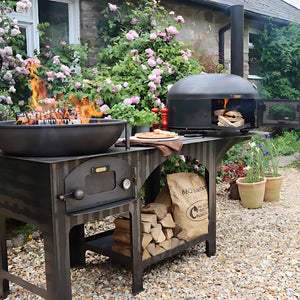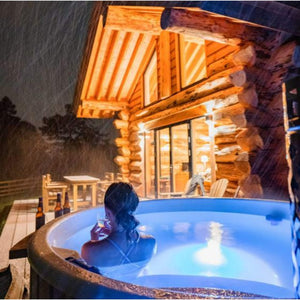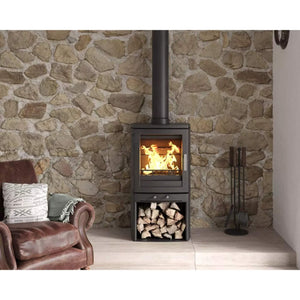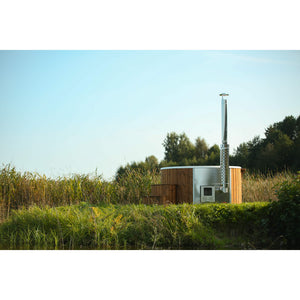News

How to Maintain Your Outdoor Steel Heating and Cooking Products
Keeping your outdoor steel cookware and heating products in good condition not only extends their lifespan but also enhances their performance. Whether you’re a seasoned grill master or a novice outdoor cook, proper maintenance of your equipment is essential.
Here’s a comprehensive guide on how to maintain your steel cookware, from seasoning to storage, ensuring they remain in prime condition for your next outdoor cooking adventure.
Seasoning Your Cookware Before Use
Seasoning is a crucial step to prepare your steel cookware for use. It helps create a non-stick surface and prevents rust. Here’s how to do it:
- Heat Your Cookware: Start by heating your steel item to a medium-hot temperature. This can be done over a fire pit or in your oven.
- Clean Thoroughly: Wash the item in warm soapy water to remove any protective coating or residues. This is important as it prepares the surface for oiling.
- Dry and Oil: After cleaning, dry your cookware thoroughly. Once dry, apply a small amount of cooking oil evenly over the surface. Any standard cooking oil, such as vegetable, canola, or sunflower oil, works well.
- Heat Again: Heat the item to a hotter temperature than the first round. During this process, it’s normal to see some smoke.
- Repeat the Process: If required apply more oil and reheat a few times until the cookware develops a dark, even coating.
Care After Each Use
Proper after-use care is essential to keep your cookware ready for the next use:
- Clean and Dry: Always wash your cookware after use and dry it thoroughly. Using heat to dry off any excess moisture ensures that no water is left to cause rust.
- Oil the Surface: Before storing, lightly coat the cookware with cooking oil to protect the seasoned surface.
- Address Rust Promptly: If rust appears, use a wire brush to scrub it off and repeat the seasoning process to restore the protective layer.
Long-Term Maintenance Tips
To keep your outdoor steel products in top condition, consider these additional tips:
- Regular Oiling: Use 3-in-1 oil to maintain the hinges of your oven doors. This prevents them from seizing up and rusting.
- Winter Storage: If possible, store components like oven doors indoors during the winter to protect them from harsh weather or ensure fully covered with a good quality rain cover.
Preventing Rust with Oils and Paints
Besides regular cooking oils, you can use specific products to prevent rust:
- Heatproof Stove Paint: A coat of heatproof stove paint provides an excellent barrier against moisture and rust. This is particularly useful for parts of your setup that are exposed to high temperatures and cannot be regularly oiled.
- Mineral Oil: For parts not exposed to heat, mineral oil can be a great option as it doesn’t harden or gum up.
By following these maintenance tips, you ensure that your outdoor steel cooking and heating products stay clean, functional, and beautiful. Whether you’re roasting marshmallows or cooking a gourmet meal, well-maintained equipment will always enhance the experience.
- Neil Finnerty

Frequently Asked Questions About Wood Burning Hot Tub Care and Maintenance
Step into tranquillity with wood-burning hot tubs, timeless sanctuaries offering relaxation and rejuvenation. Discover their therapeutic benefits for body and mind, from soothing sore muscles to reducing stress. Explore care tips and unlock the transformative power of soaking in nature's embrace.
Here is a list of frequently Asked Questions About Wood Burning Hot Tub Care and Maintenance
1. How do I clean my wood burning hot tub?
Cleaning your wood burning hot tub is essential for maintaining water quality and hygiene. Use a non-abrasive sponge or cloth along with a mild cleaner to wipe down the interior surfaces of the tub. Rinse thoroughly with clean water afterward.
- Make sure the stove has cooled down before draining the tub! Failure to do this could damage your stove.
- Drain the water out, and scrub all of the internal surfaces using a non abrasive sponge, cloth or brush and soap solution. Once complete, rinse down and refill.
- For hot tubs with liners, surfaces can be thoroughly wiped down in a similar fashion, before rinsing and refilling.
2. What should I do to prevent algae growth in my wood fired hot tub?
Algae growth can be prevented by regularly maintaining proper water chemistry. Ensure that the water pH level is within the recommended range (typically 7.2 to 7.8). Also, avoid leaving the tub uncovered for extended periods, especially in direct sunlight, as this can promote algae growth.
If the hot tub has a liner (fibreglass or polypropylene) you may use chlorine if you wish to keep using the same water for longer.
3. How often should I change the water in my wood fired hot tub?
It's tricky to give a straightforward answer because it varies! For wooden tubs, avoid using chemicals, so it's best to change the water every 2-3 days when using it often. Keep the lid on when not in use to prevent debris from getting in.
If you have a lined tub like fiberglass or polypropylene, you can use chlorine, natural equivalents or filtration systems to keep the water clean for longer, even weeks.
In places like glamping sites or vacation rentals, it's a good idea to change the water for each new guest.
In general it's recommended to change the water in your wood burning hot tub every 2 to 3 days for untreated and 2 to 4 weeks for treated depending on usage frequency and water quality.
Regularly changing the water helps maintain hygiene and prevents the build up of impurities.
4. Can I use chlorine or other chemicals to sanitize my wood burning hot tub?
Since wood-burning hot tubs typically don't have a filtration system, it's best to avoid using chlorine or other harsh chemicals. Instead, opt for natural sanitisers such as bromine or mineral-based solutions specifically designed for wood-fired hot tubs.
If the hot tub has a liner (fibreglass or polypropylene) you may use chlorine if you wish to keep using the same water for longer.
So, Chemicals can be used with lined tubs (fibreglass or polypropylene) where the water doesn’t come into contact with the timber facade but they are not required.
Using chemicals will simply allow the same water to be retained for longer, between cleaning.
5. How do I maintain the water temperature in my wood burning hot tub?
The water temperature in your wood fired hot tub can be maintained by adding more firewood to the stove or adjusting the air intake to regulate the heat. It's essential to monitor the temperature regularly using a thermometer and adjust accordingly to ensure a comfortable soaking experience.
6. What type of wood should I use for my wood fired hot tub?
Hardwoods such as oak, cedar, or maple are ideal for wood burning hot tubs due to their slow-burning properties and resistance to rot. Avoid using softwoods like pine or spruce, as they tend to burn quickly and can release resin into the water, causing potential maintenance issues.
7. How can I prevent rusting of the metal components in my wood burning hot tub?
To prevent rusting, regularly inspect metal components such as the stove, bands, and fittings for any signs of corrosion. Keep these parts dry when not in use and apply a rust-resistant coating if necessary. Additionally, ensure proper ventilation to reduce moisture buildup, which can accelerate rusting.
8. What should I do if I notice a strong odor coming from my wood fired hot tub?
A strong odor could indicate bacterial growth or an imbalance in water chemistry. First, check the water pH and sanitizer levels and adjust as needed. If the odor persists, consider draining and thoroughly cleaning the tub, including the interior surfaces and any accessories, to eliminate bacteria and impurities.
Take a look at our range of high-quality Wood Burning Hot Tubs here.
- Neil Finnerty

Your Ultimate Handbook for Choosing the Right Stove for Your Home and the Environment
In the dynamic landscape of heating solutions, the array of stove options can be overwhelming. From the traditional charm of wood-burning stoves to the efficiency of closed combustion, the eco-friendliness of eco-system models, and the environmental conscientiousness of DEFRA-approved stoves, each type brings unique features to the table. This guide aims to demystify the stove selection process, considering factors like closed combustion, convection, eco-system designs, and DEFRA compliance.1. Types of Stoves:
Wood Burning Stoves:
- Classic ambiance with the allure of crackling flames.
- Optimal for environmentally conscious users with sustainably sourced wood.
- A timeless choice for those seeking a genuine, rustic feel.
- Versatility to burn wood, coal, peat, and other approved fuels.
- Adjustable grates for accommodating different fuel types.
- Ideal for regions with diverse fuel availability.
- Sealed combustion system for increased efficiency.
- Enhanced control over airflow, resulting in efficient heat production.
- Ideal for well-insulated homes and reduced heat loss.
- Utilizes a convection process for distributing heat.
- Evenly warms the surrounding space, ensuring consistent comfort.
- Effective for larger areas and maintaining a steady temperature.
- Prioritizes environmental sustainability with advanced combustion technology.
- Focus on reduced emissions and high efficiency.
- May include features like automatic air control for optimal combustion.
- Compliant with DEFRA (Department for Environment, Food & Rural Affairs) standards.
- Designed to reduce emissions, making them suitable for use in smoke-controlled areas.
- Environmentally friendly without compromising performance.
2. Factors to Consider When Buying a Stove:
Heating Capacity:
- Tailor the stove choice to the square footage of the intended space.
- Closed combustion and convection stoves excel in distributing heat evenly.
Installation and Ventilation:
- Assess compatibility with existing chimneys or the need for a specific flue system.
- Closed combustion stoves often have sealed systems, reducing the risk of backdrafts.
Fuel Availability and Cost:
- Evaluate the accessibility and cost-effectiveness of the chosen fuel.
- Eco-system stoves prioritize sustainability with reduced environmental impact.
Aesthetics and Design:
- Harmonize the stove's design with your home's aesthetic.
- Convection stoves, with their sleek designs, offer a modern touch.
Efficiency and Emissions:
- Prioritize stoves with high efficiency and low emissions.
- Closed combustion and eco-system stoves excel in both efficiency and reduced environmental impact.
DEFRA Compliance:
- Ensure that the stove is DEFRA-approved if you reside in a smoke-controlled area.
- DEFRA-approved stoves provide an eco-friendly heating solution without compromising air quality.
Budget Considerations:
- Define a budget range, encompassing installation, fuel, and long-term maintenance costs.
- Evaluate the cost-effectiveness of closed combustion and eco-system models over time.
3. Maintenance Tips:
- Regularly clean the stove and associated components.
- Follow the manufacturer's guidelines for servicing, especially for closed combustion and eco-system models.
- Inspect and replace gaskets, seals, and filters as recommended.
In conclusion, the vast landscape of stoves, understanding the nuances of wood-burning, multi-fuel, closed combustion, convection, eco-system, and DEFRA-approved models is crucial. By weighing factors like heating capacity, design, environmental impact, and DEFRA compliance, you can make an informed decision tailored to your home's needs. Whether you lean towards the traditional charm of wood or the cutting-edge efficiency of closed combustion, the perfect stove awaits to transform your living space.
- Neil Finnerty

Exploring the Benefits of a Wood Burning Hot Tub
The Natural Luxury: Exploring the Benefits of a Wood Burning Hot Tub
Introduction: Welcome to our blog, where we immerse ourselves in the world of wood burning hot tubs, a luxurious and eco-friendly way to unwind and embrace the soothing power of warm water. In this article, we'll explore the numerous benefits that come with owning a wood burning hot tub. From the therapeutic effects to the rustic charm, get ready to discover why these natural and relaxing retreats are becoming increasingly popular among homeowners.
- Therapeutic Relaxation: The warm water of a wood burning hot tub provides a therapeutic and rejuvenating experience.
- Hydrotherapy: The combination of warm water, buoyancy, and massaging jets can help relax muscles, reduce tension, and soothe aches and pains.
- Stress Relief: Soaking in a hot tub can promote relaxation, relieve stress, and enhance overall well-being.
- Improved Sleep: The warm water can help you unwind and prepare for a restful night's sleep.
- Eco-Friendly and Energy Efficient: Wood burning hot tubs offer an environmentally-friendly alternative to electric or gas-powered options.
- Energy Efficiency: By utilizing wood as fuel, these hot tubs have a low carbon footprint and are not dependent on electricity or gas.
- Renewable Resource: Wood is a renewable resource, making it a sustainable and eco-friendly choice for heating the water.
- Connection with Nature: Enjoy the crackling sound and pleasant aroma of burning wood while connecting with the natural elements.
- Customizable and Versatile: Wood burning hot tubs can be customized to suit your specific preferences and style.
- Size and Design Options: Choose from various sizes and designs to fit your available space and aesthetic preferences.
- Personalization: Customize the hot tub with seating options, accessories, or additional features to create your ideal oasis.
- Cost-Effective: Wood burning hot tubs can be cost-effective in the long run, especially when compared to other types of hot tubs.
- Lower Operational Costs: Wood as a fuel source is generally less expensive than electricity or gas.
- Minimal Maintenance: Wood burning hot tubs have simpler mechanisms compared to electric or gas-powered ones, reducing potential maintenance and repair costs.
- Natural and Rustic Charm: The rustic and natural aesthetic of a wood burning hot tub adds a unique charm to your outdoor space.
- Warm and Inviting Atmosphere: The natural materials and crackling fire create a cozy and inviting ambiance.
- Visual Appeal: The wooden structure blends beautifully with nature, creating a visually stunning focal point in your outdoor setting.
- Year-Round Enjoyment: Wood burning hot tubs can be enjoyed throughout the year, regardless of the season.
- Winter Warmth: Experience the exhilaration of soaking in a warm tub while surrounded by the beauty of a snowy landscape.
- Summer Refreshment: During the summer months, you can enjoy a refreshing dip or use the tub as a cool plunge pool.
Conclusion: Owning a wood burning hot tub brings a multitude of benefits, from therapeutic relaxation and eco-friendliness to customization options and rustic charm. Indulge in the natural luxury and timeless appeal of a wood burning hot tub as you create a serene and rejuvenating space in your own backyard. Unwind, connect with nature, and embrace the soothing effects of warm water as you elevate your outdoor living experience to new heights of tranquility and indulgence.
Take a look at our range of Wood Burning Hot Tubs here Wood Burning Hot Tubs – Prestige Home Fires
- Neil Finnerty




